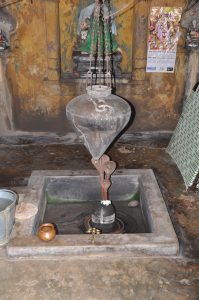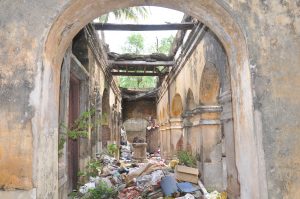The open site of the Bada Akhada Mutt is a welcome sight for the sore eyes of those who support the Mutt demolitions being done in Puri.
As promised, the small temple, the Gadi of the Mahant, and the kitchen inside the mutt were left intact. Mahant Harinarayan Das has been incommunicado since the demolition, a few of the initiates and disciples were wandering around with lost expressions. I met Atmatatvananda, who told me that they had no option other than surrendering. The mutt will be allocated land elsewhere, he said, but the historic values, the chaitanya and the heritage are lost forever.
The Bada Akhada Mutt was set up in 1352 CE by Guru Gopal Das on the advice of the council of the Panch Akhada of the Naga Sadhus. Odisha faced the wrath of the Muslim invaders from 1568 CE, when Kalapahar, the Afghan ruler of Bengal, defeated Mukunda Deva at Gohiratikiri. The Mughals replaced the Afghans and continued to rule for about two centuries. From 1402 CE onwards, the mutt had a contingent of Naga Sadhus who took it upon themselves to protect the Jagannath Temple. The Naga Sadhus were known for their military and gymnastic skills.
Like in the other Naga Mutts, the images of Sita and Ram were kept inside the temple. A statue of the founder Guru Gopal Das was also installed. The Mahant of the Mutt has always been appointed by an 18-member Naga Akhada, which usually took place during the Kumbh Mela.
The annual Rath Yatra had acquired fame by the late 17th Century. Many Sadhus of different sects could make their slow way to Puri along with their entourages, which comprised elephants, horses, camels and mules. Most of them stayed in the wayside mutts and temples, but the Nagas were not welcome due to their fierce tempers and aggressive nature. They were heavily armed with swords, sticks, spears and tridents and were the most militant of all Hindu Akhadas. Their retreats were and still are called ‘chhaavni’ or armed camps. There were designated mutts where they stayed.
The Langali Mutt at Katak was one such place for the Naga Sadhus. It was built sometime in the 1870’s, on the embankment of the Kathjori, just off the Puri Ghat. Today, the only visible sign of this old Mutt is a small arched entrance about 100 metres away from the Puri Ghat Police Station.
It is a simple small mutt like the ones found in north India. There are two temples inside the mutt. One is the Shesnag temple and the other of Lord Ram. A marble statue of Lord Ram is kept inside the main temple. In the other temple, there is a big copper vessel hanging on top of the Shivalinga, from which drops of water fall. The other rooms are the quarters for the Sadhus and the Mahant.

Half the mutt was demolished in the 1960’s and an apartment block was built on the land. Even the present Mutt has been encroached upon from three sides. The entrance archway has an interesting depiction of two Sadhus engaged in performing havan. One of the two lions at the entrance has been half destroyed. The roof beams of the temples have rotted and half the roof has collapsed. The plaster has peeled off from the walls. The roofs and walls are on the verge of collapse.
The arrival of the Nagas would send the city into a tizzy each year. Newspapers would announce their arrival, and people would flock to see them. They would enter the city in a colourful and musical parade with drums beating, bells ringing, horns blowing, and the head of the sect atop an elephant, followed by decorated horses and a large group of excited naked Naga Sadhus on foot. The Nagas looked fierce and formidable with their ash-smeared body, long matted hair and intense eyes. The locals used to keep a safe distance, the Nagas had quick tempers and there were many cases of skirmishes. Their nudity, chillums and aggressive behaviour instilled fear and bewilderment among the people of the old city. They would smoke cannabis and indulge in mock fights amongst themselves.
The Marwari and Gujarati traders of the city used to arrange food for them. The Nagas would perform their ‘Dhuni’ puja and then romp in the sands of the river just across the mutt. The Naga Sadhus would bury their heads in the sand and go on meditating for hours. They would sleep on the sand of the river bank. Old timers still remember their annual appearance. They would stop on the way back too.

Another Naga Mutt on the Old Jagannath Sadak was the Lacchman Mutt at Balkati, on the banks of the Daya River, the remains of which can still be seen. The Nagas were unwelcome in the Mutts of Puri, so they left for the Rath Yatra just a couple of days earlier, to reach just in time.
The Nabakalebara of 1950 witnessed violent clashes between the Naga Sadhus and the police. In the struggle, 200 Sadhus and 14 policemen were injured. It is also believed that a dozen Nagas were killed; the bodies were removed and buried. In 1954, during the Rath Yatra, a wheel of Lord Jagannath’s chariot gave way, and the chariots were stranded midway. The next day, a group of armed Nagas forcefully climbed the Chariot of Lord Balabhadra and attacked the policemen of duty. In the clash, 190 Nagas were injured and hospitalised and many priests and policemen too were injured. Since then, the entry of the Nagas has been banned in Puri.
The ownership of Langali Mutt at Katak is under dispute. The section which has the two temples is in a very bad condition. The entire complex is on the verge of collapse. The Lacchman Mutt at Balkati is an abandoned structure near the bank of the river. It is now used to store cow-dung patties by the nearby locals. These important vestiges of the Old Jagannath Sadak should be properly restored.


Comments are closed.